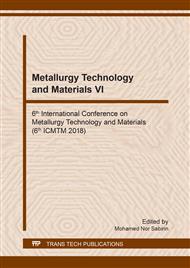p.208
p.217
p.222
p.230
p.235
p.240
p.247
p.255
p.261
Application of Response Surface Methodology to Optimize the Process of Saponification Reaction from Coconut Oil in Ben Tre - Vietnam
Abstract:
Response Surface Methodology (RSM) is used to optimize the conditions of the saponification reaction (Concentration of alkaline solution (%), temperature (°C) and reaction time (hour)). Level of foaming and durability of the emulsion (cleaning ability) from the product of the saponification reaction are two factors to evaluate the optimization process by RSM. After optimization, the alkaline solution concentration is 11%, the reaction was carried out for 2.5-3 hours at 85°C for the highest level of foaming and the most prolonged durability of the emulsion. This parameter was compared with the experiment, and the results showed that there was no significant error, this proves that the RSM model has good repeatability, can optimally correct and is essential in optimizing the survey parameters.
Info:
Periodical:
Pages:
235-239
Citation:
Online since:
August 2018
Price:
Сopyright:
© 2018 Trans Tech Publications Ltd. All Rights Reserved
Share:
Citation:


